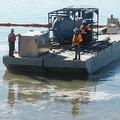 田納西州東部煤灰填埋場2008年12月間外洩10億加侖(約合45.5億公升)有毒泥狀物,並且污染了水源,然而此意外恐怕非單一事件。環保人士7日發佈一項報告指出,全美有將近100個煤灰垃圾場暴露在與其類似甚至更高的危險之中。
田納西州東部煤灰填埋場2008年12月間外洩10億加侖(約合45.5億公升)有毒泥狀物,並且污染了水源,然而此意外恐怕非單一事件。環保人士7日發佈一項報告指出,全美有將近100個煤灰垃圾場暴露在與其類似甚至更高的危險之中。
這項研究警告說,布希政府一直以來妥協於工業界的要求,對煤灰儲存池存在的風險視而不見,使得這些傾倒場得以逍遙在聯邦法令規範之外,且大部分並未受到監管。
主持這項新研究的「環境正義計畫」(Environmental Integrity Project)主任薛佛(Eric Schaeffer)表示,那場12月22日在田納西河谷管理局(Tennessee Valley Authority)管轄的金斯頓(Kingston)燃煤火力發電廠所發生的災難,充分表現出「此種填埋方式欠缺法令約束,沒有任何藉口」。
「環境正義計畫」分析工業界申報給美國環保署(Environmental Protection Agency)的資料後發現,在這些煤灰儲存池中含有類似金斯頓受災場址所發現的6種重金屬元素:砷(arsenic)、鉻(chromium)、 鉛(lead)、鎳(nickel)、硒(selenium)及鉈(thallium )。
分析人員發現包括金斯頓煤灰儲存場在內有將近100個場址,曾經在2000-2006年間傾倒總計超過1億2400萬磅(約合5625萬公斤)含有那6種金屬物質的煤灰。
薛佛表示,以有毒金屬持續且長期地滲漏到飲水源頭的狀況,這些場址附近社區所面對大量滲漏物的風險不是僅像田納西州的程度,還可能更大。
 這份報告顯示,共有13個州內各自有至少3處煤灰傾倒場名列在前50名毒性化學物質含量最高的場。印第安那州名列前茅,有11個場榜上有名;其次是俄亥俄州,有8個場在名單上;肯德基州及阿拉巴馬州各有7個場;喬治亞州及北卡羅來納州各有6個;西維吉尼亞州及田納西州各有4個;佛羅里達州、伊利諾州、密西根州、賓夕凡尼亞州及懷俄明州各有3個場。報告顯示,田納西河谷管理局金斯頓場除了鉈含量之外,其他有毒金屬含量都在50名之內。
這份報告顯示,共有13個州內各自有至少3處煤灰傾倒場名列在前50名毒性化學物質含量最高的場。印第安那州名列前茅,有11個場榜上有名;其次是俄亥俄州,有8個場在名單上;肯德基州及阿拉巴馬州各有7個場;喬治亞州及北卡羅來納州各有6個;西維吉尼亞州及田納西州各有4個;佛羅里達州、伊利諾州、密西根州、賓夕凡尼亞州及懷俄明州各有3個場。報告顯示,田納西河谷管理局金斯頓場除了鉈含量之外,其他有毒金屬含量都在50名之內。
薛佛指出:「我們的分析確認這個問題在規模上已真正成為全國性的了,田納西州事件最終可能只成為未來更多問題的一個警訊而已。」
「環境正義計畫」的報告建議分階段清除所有有毒煤灰的濕式儲存物,在2009年底之前立即對現有的煤灰儲存及處理場址與法規進行檢查及監控。
聯合山區防禦組織(United Mountain Defense)是一個位於田納西州納許維爾(Knoxville)的環境保育團體,組織裡的專任律師艾爾文(Christopher Irwin)表示:「這個露天的煤礦有毒廢氣物處理場一定得走入歷史」。
田納西州的毒物滲漏事件是由金斯頓場40英畝的煤灰儲存池破裂而導致的,而這份報告是在其鄰近的賀禮門(Harriman)社區正因遭到波及而全力進行善後的時候發表的。
那次的滲漏傾洩出540萬立方碼(約合407立方公尺)的煤灰爛泥,並且污染了艾默里河(Emory River)及克林曲河(Clinch River)匯集處超過400英畝的水源,有12間民房及其他建築物被掩埋在4英呎高的泥漿之中。
聯邦及私人的分析結果都顯示,一系列重金屬的濃度都有升高的情形,其中砷濃度超過最高允許濃度的149倍。
Nearly 100 coal ash dumps across the United States pose similar or even greater potential dangers than the eastern Tennessee site that spilled a billion gallons of toxic sludge and contaminated water last month, finds a report released today by environmentalists.
The study warns that the Bush administration has turned a blind eye to the risks of coal ash ponds, bowing to industry wishes and leaving the sites free from federal regulation and largely unmonitored.
The December 22, 2008 disaster at the Tennessee Valley Authority's Kingston coal-fired power plant highlighted the "inexcusable lack of regulation of this kind of disposal," said Eric Schaeffer, director of the Environmental Integrity Project, which produced the new study.
EIP analyzed industry data submitted to the U.S. Environmental Protection Agency on the presence of six heavy metals - arsenic, chromium, lead, nickel, selenium and thallium - in coal ash ponds similar to the one that ruptured at the Kingston site.
Analysts found nearly 100 sites, including the one in Kingston, where more than a total of 124 million pounds of coal ash containing the six metals have been disposed between 2000 and 2006.
Nearby communities are not just at risk from huge spills like the one in Tennessee, Schaeffer said, but are at perhaps even greater risk from the steady, long-term leaching of toxic metals into drinking water supplies.
The report finds that a total of 13 states have at least three coal ash dumps on the 50-worst toxic chemical lists.
Indiana tops the list with 11 sites, followed by Ohio with eight. Kentucky and Alabama have seven sites, Georgia and North Carolina have six each, while West Virginia and Tennessee have four. Florida, Illinois, Michigan, Pennsylvania and Wyoming each have three sites.
It found the TVA's Kingston site was in the top 50 for all of the heavy metals except for thallium.
"Our analysis confirms that this problem is truly national in scope and that Tennessee may end up only being a warning sign of much more trouble to come," Schaeffer said.
EIP's report recommends the phaseout of all wet storage of toxic coal ash, immediate inspection and monitoring of existing sites and federal regulation of all coal ash storage and disposal by the end of 2009.
"This open pit disposal of toxic waste has got to end," said Christopher Irwin, a staff attorney with United Mountain Defense, an environmental group located in Knoxville, Tennessee。
The report comes as the Tennessee community of Harriman is struggling to come to terms with the devastation left by the spill, which occurred after the retaining wall of a 40-acre coal ash pond ruptured at the Kingston site.
The spill dumped some 5.4 million cubic yards of ashy sludge and contaminated water across 400 acres at the confluence of the Emory and Clinch Rivers, burying 12 homes and other buildings in more than four feet of sludge.
Federal and private analyses have found elevated levels of an array of heavy metals, including arsenic levels of more than 149 times the maximum allowable levels.


